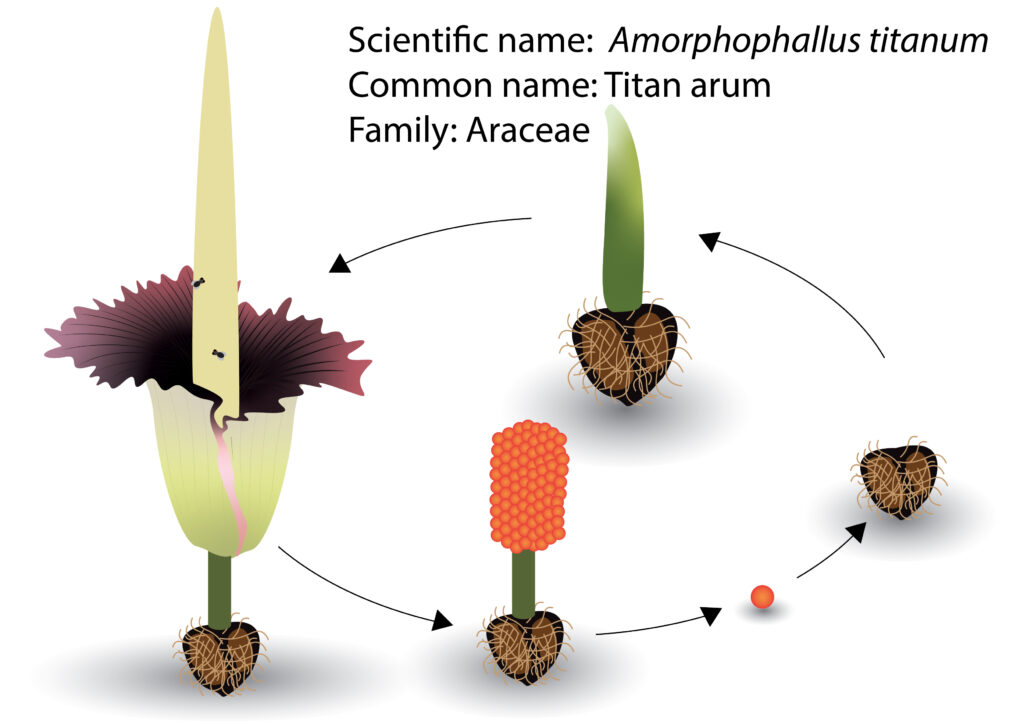The largest flower is Rafflesia. Do you know what the largest inflorescence in the world? Yes, the answer is Amorphophallus titanium that is commonly known by the public as the corpse flower. Amorphophallus titanium is the largest inflorescence consisting of a sizeable encircling bract or known as spathe, purple from the center of which emerges a fleshy spike tiny flower. It is categorized as monoecious in which the male and female flowers arranged in a separate zone but found on the same individual. The yellowish milky color spike terminates in a base portion that is botanically referred to as a ‘sterile appendage’. The plant has an impressive size, which may reach up to eight feet tall and five feet across. It is originated from Sumatra, Indonesia. Due to its increasing popularity, it is now cultivated, and the specimen can be found in the Tropical House at Kew Gardens, London, for over a century that flowers every decade or so.
Most of the species that is about one hundred species come from tropical Asia and Africa. They appear as a leafless plant in the tropical dry season that is dying back to a large underground tuber. They set up the flowers in which they are followed by a single and profoundly lobed leaf that may be pretty large and long-stalked at the start of the wet season. It is a bulbous plant characterized as a carrion flower, which is also known as titan arum or corpse flower due to its awful smelly during the blooming period. Interestingly, the literal translation of Amorphophallus titanium is ‘deformed penis’. This plant has a large and often knob-like structure that acts as the source of the foul smell, which is given off by many of the flowers of the same species. Furthermore, some places grow this plant for its edible roots like A. rivieri ‘Konjac’ and A. campanulatus.
Species from this genus are primarily found in tropical and frost tender. The plants under this genus favor certain growing conditions, like a semi-shady area sheltered at a humid position with deep, fertile, and humus-rich soil. They need frequent watering well in the summer growing season to prevent the soil from drying out. After the foliage dies back in the fall, the tuber can be kept dry so that it can regrow again. Therefore, the primary propagation is mainly done by transplanting the tubers, which usually multiply by the small offsets. It is also possible for it to propagate through the yellow-gold to a more orange-red tone fruit. The inflorescence can be pollinated with the help of insects, specifically flies. This is because the inflorescence produces a stinky odor similar to a rotting animal-like odor to attract flies. It was found that such volatile gas consists of organic acid, aldehyde, amine, and ester that are categorized in the sulfur category, thus giving a rotting odor. In addition, it contains high concentrations of dimethyl trisulfide and dimethyl disulfide as the volatiles present in the inflorescence at the end of the flowering stage. It is believed that the volatile compounds are evidence of the process of evolution.

Further readings:
van der Pijl, L. (1937). Biological and physiological observations on the inflorescence of Amorphophallus. Recueil des travaux botaniques néerlandais, 34(1), 157-167.
Kohlenbach, H., & Becht, C. (1987, August). In vitro propagation of Amorphophallus titanum Becc. and Amorphophallus rivieri Durieu. In International Symposium on Propagation of Ornamental Plants 226 (pp. 65-72).
Shirasu, M., Fujioka, K., Kakishima, S., Nagai, S., Tomizawa, Y., Tsukaya, H., … & Touhara, K. (2010). Chemical identity of a rotting animal-like odor emitted from the inflorescence of the titan arum (Amorphophallus titanum). Bioscience, biotechnology, and biochemistry, 74(12), 2550-2554.
Iwashina, T., Uehara, A., Kitajima, J., & Yukawa, T. (2015). Anthocyanins and other flavonoids from Amorphophallus titanum having largest inflorescence in plant kingdom, and other two species. Bull Natl Mus Nat Sci. Ser, 41(1), 33-44.